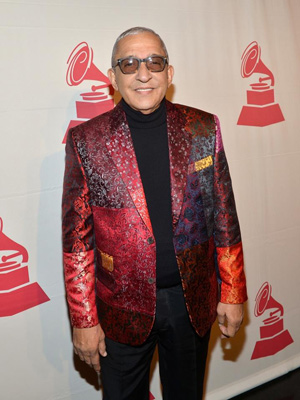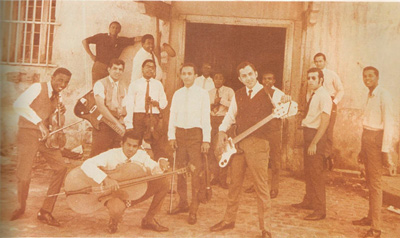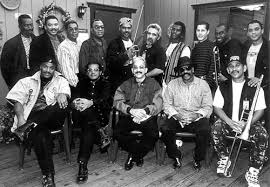Tribute to Juan Formell and Los Van Van
Jorge Dalton*

HAVANA TIMES — I knew about the Los Van Van from the very beginning since the orchestra was formed in December 1969, when their songs started to become part of the daily life of Cubans on the island. Back then, I was a skinny little kid, all head and teeth and nothing more. The name of the group came out of the popular enthusiasm generated by the challenge of harvesting 10 million tons of sugarcane in 1970.
The government set the target, mobilized the population Chinese-style and put all the resorces it had into the great effort. One of the slogans I remember most and that was repeated continually in the press, radio, cinema and television, played on the word VAN, for “go” in English. So you got “LOS DIEZ MILLIONES VAN.” Or “Go for the Ten million. And “Y DE QUE VAN, VAN.” Or “Go for it. Go”. And that’s how the name “Los Van Van” came about.
The great sugar harvest that “would lift Cuba out of poverty forever,” was acclaimed repeatedly in speeches and in economic plans. But as we all know now, the 10 million harvest was a flop. However, despite the national disaster, Los Van Van Orchestra went from better to better, became a musical phenomenon and eventually one of the most famous popular groups in the history of Cuban popular music. Worldwide too, I would say.
Of course, at that time my friends and didn’t hold Cuban music in high esteem and the youth of the time was divided into two camps: those of us who were trying to get more tuned into music “in English” and got labeled all sorts of nasty things including “ideological deviants” (by officialdom) and at the same time we despised and looked down upon the fans of Cuban music.
There was also an element of racism in the musical equation, strong and deeply rooted in Cuban society and for many, listening to Los Van Van and other popular music groups was like listening to black music. It was a time when there were all sorts of acute crises happening at the same time. There was still an atmosphere of prohibition and censorship of “English music”, the Beatles, “long-haired hippies,” homosexuals, artists and intellectuals, religious types, Catholics especially and those Protestant religions whose doctrines, not knowing any better, rejected the revolution. Even more notorious were the effects of the US economic embargo while the Sovietization of the Cuban Revolution was at its height.
You have to remember these were also times when Cuban culture was seriously challenged and Cuban music went into decline from that decade on. One of the best examples of the scene at the time was this a singer with a hat and cane called Jarry Lewis who became famous for a song that really scraped the bottom of the barrel, about working, and that began “Trabajandooooo!” To top it all, Cuban radio and television would air groups and singers from the Soviet Union and the socialist countries that were also truly awful. Morning and evening on the radio they had these Russian language lessons going: “rusky izik pa radio.” We were truly surrounded.
Los Van Van emerged like a shining light in the darkness, starting with a singer called Miguel Angel Rasal, born in El Cerro and nicknamed “Lele” or “El Cabezon” a fanstastic interpreter who had this special way of singing: moving his head and his body which grabbed the attention of the island’s public. One of the most famous refrains at the times went: “Van Van, I know they’re going Van Van, Van Van”.
Then I ended up in a rural boarding school out in the countryside (Escuela Secundaria Básica en Campo or ESBEC) away from home and Havana under what they called the April 19 Plan between the towns of Bejucal, Quivicán y La Salud. The 70s were starting and among the songs of Los Van Van that were a hit and getting the girls going at my school was one that went: “A school in the country and a weekend in Havana. Youth’s a divine treasure. You’re young and you’ve got it all. A school in the country and a weekend in Havana.”
All the rage also were songs like “La Bola de humo”, “Yuya Martínez”, “La Candela”, “Qué se sepa”, “Dale dos”, “Te traigo”, “Marilú” , “Televisión a colores, que bien se ve” and “dame, dame la compota, aguuuú, abre, abre la boquita, aguuuuú”.

But despite it all I preferred the recordings of Arsenio Ferrer, the “Pestillo” brothers and “Pocholo” (Rafael Fernández Morera) on the weekends in the neighborhooods, down in La Víbora and El Casino Deportivo or rock groups like “Los Almas Vertiginosas”, “Los Magnéticos”, “Los Dada”, “Flores Plásticas”, “Sesiones ocultas”, “Los Antúnez” that got people jumping at festivals in el Vedado, Marianao, Lawton and Miramar. Or listening to North American and British groups on the hit parade, tuning into radio stations in South Florida like WQAM (“LA DOGLIU”) that I picked up on my little Soviet SOKÓL, stretched out on the ground, gazing up at the sky, floating among the shrews, hidden between rows of planted okra, tomato, pepper or floating on a Philippine mango matt. My ideology was the sweet kisses of a girlfriend I didn’t have, with no need for a future nor the least interest in conforming to any sort of pattern of behaviour.
I started to appreciate Cuban music when Irakere came onto the scene in 1973 with “Bacalao con pan” that they put on to rock neighborhood parties in Havana. It caused about as much sensation as “Born on the Bayou” by the Creedence Clearwater Revival or Iron Butterfly’s “In a gadda life”. That made me see and hear Los Van Van in a different way because of their use of electric guitars, electric violins, pianos and drums, contemporary tonalities mixed with the drums, the chequeré, guiro, started to sound appealing. Besides the group wore clothes that clung to their bodies, some of them with flared pants. Juan Formell flipped his bass around the way the rockers of the time did, but playing Cuban music. Little details like that started to attract my attention.
Then it was March 1979. Cuba and the United States were about to normalize diplomatic relations. It was never as close as it was then and they even opened the US interests section in Havana and a Cuban office in Washington. Jimmy Carter managed to scrub out a few paragraphs of the economic embargo in place since the Cuban Missile Crisis. In the United States, there was a lot of willingness within the Democratic Party to resume talks aimed at normalizing relations.
In those 17 moments of spring, you had one of the most important musical events in Cuba of the 70s and that was the “Havana Jam” concert, an initiative prompted by CBS directives. The concert was held at the Teatro Karl Mark on 2,3 and 4 March, with the participation of leading figures in Cuban music like Irakere, Pablo Milanes, La Orquesta Aragon, Los Papines, Manguaré, Sara Gonzales, Tata Guines Frank Emilio, Juan Pablo Torres and Elena Burque among others. From the United States there was Kris Kristofferson, Rita Coolidge, Stephen Still, Billy Joel, Bonnie Bramlett, Mike Finnegan, Dexter Gordon, Stan Getz, the Weather Report jazz-rock band with the legendary bassist Jaco Pastorius, and the Fania All Stars orchestra, kings of the phenomenal “Salsa” with Ruben Blades doing the vocals.
I remember being able to go because my friend José Luis Llanes managed somehow to get us in. I think I was in the eleventh grade at the time. What struck me most about the show and what I suddenly realized was that the Cuban musicians sounded just as good as the Americans and some were just as great virtuosos.
I knew everything about the Americans that came, was a fan of Stephen Stills as a member of Crosby, Stills, Nash & Young and I knew them all. I also knew all the songs of Billy Joel who was at the top of the charts in the US at the time and at the height of his fame. I also knew from listening so often to “La DUGLIU”. But as far as Cuban musicians were concerned I knew absolutely nothing and although I had heard the names of most of the national players, I wasn’t interested in them till then.
The other key aspect was getting tuned into jazz. I couldn’t get the performance of Weather Report and Patorius out of my head. Irakere getting into their Adagio of Mozart, was fantastic; out of this world. The thing was this big musical salad they were serving up at that momentous concert was nothing less than the meeting of two major worlds of music and not “an ideological dalliance between the musicians of the revolution and musicians of the empire” as Antonio Perez Herrero, Head of the Ideological Department of the Central Committee, dubbed it.
But come 1980, rapprochement hit the rocks with the El Mariel exodus. The American far right was unwilling to go any further and undermined not only Carter’s approch to Cuba but torpedoed the Carter administration as well. The Soviet Union, with Leonid Ilyich Brezhnev, a leader of the Stalinist old guard, at his head, was having none of this canoodling between Cuba and the US. And an uncompromising sector within the Central Committee of the Cuban Communist Party was of the same mind. And so the whole deal went down the tubes. The Cuban nation was divided even more than it was already with an unprecedented flood of Cubans heading for Florida. The Cold War suddenly turned red hot.
Although Los Van Van did not take part in the “Havana Jam” they shot to the top and stayed there permanently with the 80s their finest period which is when they became known worldwide through the extensive touring they did and the international acclaim they received. They started being known as Juan Formell and Los Van Van with Pedrito Calvo, a gutsy singer with the on-stage energy of a hurricane sweeping the Caribbean.

You needed to be there to know what I’m saying. When Juan Formell and Los Van Van, started playing in a stadium, theater or square crowded with thousands of fans, people blew their top. The numbers on every disc they brought out became hits as was the case with ““Se acabó el querer”, “Anda, ven y muévete”, “Que pista”, “El baile del buey cansado”, “La Habana si”, “Báilalo eh! Ah!, “Eso que anda” and many more.
Between 1998 and 1990 I became one of the youngest directors of Televisión Cubana and Jorge Luis Pacheco, director of Channel 6’s music programming suggested I make a new program completely different from what they normally did and on primetime. There was only one hitch, there was no funds, no studio and no gasoline, just a camera, a sound man and a little working group with Guille Vilar as writer, Gladys Infante as adviser, Glorita Dilys editor, Thomas Pliego production assistant and actress Lili Rentería hosting.
It was like making a mamey milkshake without mamey, with no milk and no blender. So I decided to make a music program that I titled “A Capella” from the idea of riding bareback or without a saddle. Pacheco was the first to support the idea until they moved me over to Cubavisión International.
The show came from nowhere to become one of the most viewed programs on Cuban television, and my formula of “in the absence of rhinos” was to just to record the program on the ICRT terrace, at a stop bus, with an umbrella, with cardboard boxes, whatever I could get my hands on because I felt it was an opportunity to do something different. But that way of working wasn’t to the liking of the “comrades” who said I just couldn’t go around shooting programs on a terrace that was of “strategic” importance. So they were forced to give me a TV studio in the end.
But what drove the program was presenting music in English and Cuban music on the same level, without distinction. For us, Juan Formell and Los Van Van, were just as important as the Beatles, Chicago, The Rolling Stones and Earth, Wind & Fire. Silvio Rodriguez and Pablo Milanes were the same as Lennon and McCartney. Janis Joplin, Linda Ronstadt and Ella Fitzgerald were as great as Elena Burque, Moraima Secada and Omara Portuondo.
Bola de Nieve was as big as Louis Armstrong and Rita Montaner was as good as Billie Holiday and so on. Gonzalito Rubalcaba was as great a virtuoso as Chick Corea and Michel Camilo. Cuarto Espacio, Afro Cuba and Diakara were just as good as Spyro Gira or Yellowjackets. The Cuban public began to appreciate Jorge Chikoy in the same way as Pat Metheny, Changuito, Tata Guines, Los Papines and Anga were just as great artists as Billy Cobha, Ray Barretto, Airto Moreira, Tito Puentes and Giovanni Hidalgo.
That was why “A Capella” was such a success and was also dedicated to promoting new values in Cuban music of the era in a way that others failed to do. Which was the case with: Carlitos Varela, Santiaguito Feliu, Gerardo Alfonso, Sintesis, Donato Poveda, Monte de Espuma, Tanya, Amaury Perez, Jose Maria Vitier, Ramon Valle, Pucho Lopez. The “hippies and the rockers” merging like some kind of obsessive kid trying to put a jigsaw puzzle together, with Compay Segundo (unheard of and basically unknown in those days) with Los Compadres, Celeste Mendoza, Los Zafiros, Yoruba Andabo, Peyo el Afrokán among others. And all this merged with the best in Brazilian music, from Argentina, Colombia and the rest of Latin America, jazz, classical music and songs from the so-called New Song Movement.
Some people said: “Are you crazy”. And I’d say: “Yes, you’re absolutely right. Because you have to be crazy to buck the established music scene.” Danilo Sirius, director of Cubavisión and my boss at the time was always saying to me, “Nice mess you’ve landed me in again, Dalton.” Others who had it in for me said I was out to prostitute Cuban music and should get kicked out of the Institute of Radio and Television. And another thing they asked, who’d given me permission anyway?
It was a heady cocktail that the party “comrades” turned up their noses at. No-way were they going to give me the green flag. So they’d be pussy-footing, going: “Like, I don’t know what the hell percentage is English music, and what the fuck percentage is Spanish music.” But I wasn’t giving a shit about their percentages and had tremendous bust-ups within the ICRT, especially with the “comrades”.
But we won the battle in the end because along with some others who were in the ICRT doing top shows like “El programa de Ramón” combined with the new brooms sweeping the ICAIC Film Institute, the new artistic values coming out of the Escuela Nacional de Arte and El Instituo Superior de Artes, we were seeing the birth of the notorious movement of artists that emerged from the Revolution; we were “the sons of William Tell” and ended up by knocking down the wall thrown up in 1965 and getting rid of it permanently, fortunately.
Came the 90s, crises came and went but Formell and Los Van Van shook up Cuba with the joy and delight of their powerful sound that echoed across the island and beyond like never before to the beat of “Que le den candela”, ” Aquí el que baila gana”, “Que no, que no”, “El negro no tiene ná caballero”, “La Titimanía” and “Chirín Chirán, QUE YA SE ACABÓ!!! ”
Excuse me, ladies and gentleman, but I have to break off now. I’m getting too sentimental and at a loss for words describe the greatness and genius of Juan Formell and the musicians of his unparalleled orchestra. Thanks to him I became a fan of his music and Cuban music in general. The legacy of a genius as great as Formell will survive for ever. Call me crazy if you like but let me tell you something. Wherever the history of world music is written, Juan Formell will have a place in it. No real history of world music can be written without him. That’s something every Cuban, god and the world, might reflect on. And give him his due.
—–
(*) Jorge Dalton – Cuban-Salvadorian filmmaker: Considered one of the cinematographic authorities of the Central American Region, he is currently one of the leading filmmakers of Central America and the Caribbean. Former student of Argentine filmmaker Fernando Birri and Cuban documentary filmmaker Santiago Alvarez. Dalton was a founder of the International Film and Television School of San Antonio de los Baños, Cuba and was one of the most prominent filmmakers of Cuban Television in the late 80s and early 90s. He currently lives in El Salvador and is Director of Cinema and Audiovisuals of the Secretariat of Culture, Government of El Salvador. He helped set up the National Cinemateca of El Salvador and the National Film Institute of El Salvador (INCINE) and is also a key figure in the new cinema and audiovisual panorama of El Salvador and the rest of Central America.






Good article. Unfortunately, Formell’s death escaped many “experts” across the world. “Despues de Todo” filmed in Peru relatively recently and available on You Tube is a good example of just how far the group had come. Will never forget how Formell explained slipping a slow melody ( maybe on the flute) into the contrapuntal texture of an up tempo montuno section: ” when I watch the dancers, some move fast and some move slow to the same tune at the same time.”
Thank you. This is such a great essay. So informative and lively. A piece of history given through personal experience.